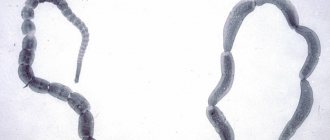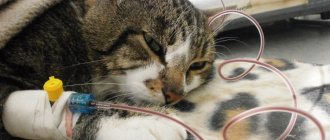Hookworm infection is an infection with helminths that can occur in both humans and animals: cats and dogs . Hookworm is the main causative agent of hookworm in animals and humans, which thrives in tropical and subtropical climates and lives primarily in the soil.
Necatoriasis is another disease caused by this parasitic organism. The symptoms of the disease are incredibly similar to hookworm, which is why the diagnosis is often misdiagnosed. Such worms infect the respiratory system and intestinal tract of the host. The main symptom of hookworm infection is skin lesions and anemia.
Helminths in cats
Parasites cause enormous damage to the animal’s body, undermining its protective functions and injuring internal organs. The cat family is most often susceptible to attacks by two types of worms:
- nematode roundworms;
- tapeworms cestodes.
The risk of infection is high: helminth eggs are found in the soil and are resistant to environmental conditions.
Table 1. Description of cestodes and nematodes
| View | Description | Method of infection | Common diseases |
| They mainly live in the digestive system. They can also be encapsulated in other organs. Feeding on food bolus | Through food or skin, less often in utero | Toxocariasis, hookworm | |
| They live in the intestines, clinging to its walls and injuring tissues. Food source is blood. Most often found in adult worms | When ingesting larval vectors | Teniosis, diphyllobothriasis |
Consequences of helminthiasis
The prolonged presence of parasites leads to anemia and degeneration of internal organs. The clinical picture of other diseases against the background of helminth infection becomes more complicated.
Complications are caused by intoxication of the animal’s body, which is caused by the activity of worms. With mass infestations, pets suffer from intestinal obstruction. This pathology causes intestinal rupture, which can be fatal.
Table 2. Pathological processes during helminthic infestation
| Pathological process | Description |
| Metabolic disease | As a result of the vital activity of parasites, special toxins are released, which are allergens and poisons. The concentration of these elements in the body leads to disruptions in the metabolic process |
| Vitamin deficiency in the pet's body | By feeding on the blood or food bolus of the host, parasites steal nutrients. As a result, the animal does not receive enough vitamins and beneficial elements in the food. |
| Intestinal dysbiosis | Products resulting from the activity of worms in the body provoke the development of dysbacteriosis. To avoid being digested in the intestines, parasites secrete antienzymes for protective purposes. These substances lead to an imbalance between beneficial and pathogenic microflora |
| Decreased immunity | Helminths destroy white blood cells designed to fight infections |
| Impaired blood supply | Some varieties of worms parasitize on the walls of organs, attaching to them using special suction cups. In addition to feeding on blood, they cause tissue death. Becoming larger in size, helminths put pressure on neighboring tissues, which can impair blood supply |
Biology
Hookworm is a small, 5–13 mm long, filamentous nematode. Adults live in the intestines, and the eggs laid are excreted in the feces. The larvae hatch from them and remain viable in the soil for a long time. They enter the cat's alimentary tract with water or by licking contaminated paws. However, another route of infection is also possible - through the pores of intact skin. In this case, the larvae are carried into the trachea by the bloodstream and feed there for some time.
For puberty, the hookworm must enter the intestine. The activity of parasites is accompanied by the addition of secondary microflora, the development of inflammation, coughing and ingestion of larvae. Intrauterine infection of kittens usually does not occur, but immature hookworms wander throughout the body, enter the secretions of the mammary glands and infect sucklings.
Hookworm in cats
Hookworms are typical parasites of cats and dogs.
Hookworms is the English designation for this type of worm. The term literally translates as hook worm, which accurately reflects the appearance of the parasite. In the area of the head it has a special hook with which it is fixed to the intestinal walls.
Characteristics of the helminth:
- light pink color;
- body thickness up to 0.6 mm;
- male length up to 1 cm;
- female length up to 2 cm;
- the number of eggs per day is up to several thousand;
- puberty period from 2 to 3 weeks;
- The shelf life of eggs in humid conditions is up to 2 years;
- food preferences blood and small intestinal tissue.
There is no intermediate host in the worm development chain.
The mechanism by which the helminth enters the animal’s body may be different. The worm enters through the skin or food, less often in utero. Unsanitary conditions and crowded housing are the main culprits for parasite infestations. In cat shelters, for example, the infection rate can reach 100%.
Life cycle
Depending on the conditions of penetration into the body, the life cycle of hookworms may differ.
The larvae enter the intestines along with contaminated water or food.
Given the excellent swimming abilities of the larvae, rainy weather poses a particular danger for pets. Hiding in raindrops, on the grass or in puddles, they wait for the opportunity to attack a passing animal.
In rare cases, the larvae migrate through body tissue, becoming encapsulated in organs or muscles.
Compared to dogs, cats are considered carriers of a small number of hookworm varieties. In addition, cat parasites do not cause such dangerous consequences for the pet’s life. For example, babies of infected bitches become infected with helminths while in the womb. Such situations practically never occur among cats. However, worms can be passed from mother to baby through breastfeeding.
Symptoms of hookworm
The disease caused by the presence of hookworms in the body is called hookworm. At an early stage, the disease practically does not manifest itself. By attaching to the walls of the small intestine, parasites feed on its tissues. However, this process does not cause much discomfort to pets.
The situation becomes more complicated when the worms begin to feed on blood. To obtain more red liquid, they create small wounds in the organ and inject a substance into them that prevents blood clotting.
The action of the anticoagulant leads to disruption of the animal's blood supply. Damage left by parasites bleeds for a long time and causes pain. Kittens especially suffer from blood drainage. Children quickly develop anemia.
Manifestations of hookworm:
- anemia;
- lack of appetite;
- apathy;
- bowel disorders;
- hair loss;
- itching in the anal area;
- mucous discharge from the eyes;
- the presence of undigested blood in the stool;
- rapid weight loss;
- inflammation of the paw pads;
- pale gums;
- tarry color of feces.
Dull hair is also a warning sign.
Diagnosis of the disease
Diagnosis of pathology is carried out by microscopic examination of stool.
The number of eggs found in stool does not always indicate the number of eggs present in the body. When there is excessive accumulation, the parasites begin to suppress each other. This leads to situations in which, during an exacerbation of the pathology, fewer eggs are found in the feces than during a mild form of the pathology.
In small kittens, the disease is not always determined by the presence of eggs in the feces. Even if they are absent from the stool, dangerous parasites may already live in the baby’s body. In this situation, diagnosis is made based on indirect symptoms.
Video Hookworm: the causative agent of hookworm
Symptoms
There are several indirect symptoms that will help detect a disease in a cat:
- the cat eats poorly and loses weight quickly;
- usually a cheerful cat refuses playfulness, behaves quietly and moves reluctantly;
- the animal is vomiting;
- problems with bowel movements;
- the cat’s mucous membranes turn pale, including the gums;
- the coat becomes matted, looks old, dull, unkempt, or falls out;
- hematomas from bites are found on the paws;
- One of the signs of the disease is that the stool takes on a darker color.
In addition, bright blood spots, which appear during anemia, can be found in the animal’s feces. Parasites, biting through the walls of the small intestine, leave bleeding wounds that do not heal for a long time under the influence of their saliva. Sometimes bite wounds reach two centimeters in size. In this case, a lot of blood is lost and the animal suffers from iron deficiency.
An accurate diagnosis, taking into account the symptoms and characteristics of the cat, is established by a specialist. He also takes stool samples and tests them for parasite eggs.
Treatment of hookworm
Despite the danger of the pathology, it is easily treatable. Especially when parasites are detected at an early stage of their development.
Basic rules of treatment:
- A sick pet should be isolated from healthy animals while fighting the disease.
- Both medications and traditional recipes are used.
- New generation anthelmintic drugs contain either one active ingredient, the action of which is aimed at combating a specific helminth, or several. Since a pet is often infected with several parasites at the same time, it is advisable to choose a multifunctional product.
- In parallel with therapy, the animal should be switched to therapeutic food. This measure will help cope with anemia.
- Veterinarians recommend using medications containing iron, folic acid and B vitamins. Taking these medications helps restore red blood cells and stimulates the hematopoietic organs.
- 1 month after the end of treatment, you need to do a repeat stool examination. If helminths are found in the feces, undergo a second course of therapy using a different anthelmintic drug.
If the disease progresses to an acute stage, a blood transfusion may be required.
Folk remedies
Home medicine recipes are not as effective as pharmaceutical products. However, they can be used as a concomitant treatment.
- Sugar cubes. Give it to your pet several times a day, mixing it with food or pouring a sugar solution into the esophagus using a syringe.
- A decoction of chamomile or fennel. Brew 25 mg of the collection in 250 ml of boiled water and give it to drink instead of drinking water.
- Onion. Cut the vegetable into 4 parts, pour 1 glass of warm water and give in the morning on an empty stomach.
- Infusion of common tansy. 1 tbsp. pour 250 ml of boiling water over the flowers and leave. Give 3 times a day 30 minutes before meals.
- Alcohol tincture of wormwood. This pharmaceutical product is given to the cat 10 drops 2 times a day 1 hour before meals.
Duration of treatment until complete recovery.
Medical nutrition
To support your pet's body while fighting parasites, you should put the animal on a high-calorie diet. Parasites absorb the nutrients your pet needs, so it is necessary to make up for their absence.
Basic dietary canons:
- Eliminate raw foods from the menu, especially fish.
- Meat products and eggs should make up up to 65% of the diet.
- It is useful to add 1 tbsp to food. olive oils. This measure will help increase the fatty component of food.
- Despite the ban on raw foods, liver is an exception. It will help increase your iron levels. Recommended dose 1 time per day for 2 weeks.
- Taking vitamin supplements. Kittys Mix, Phytomins, Hematocat will perfectly strengthen your pets' immunity.
- Taking enzyme medications. These medications will help you absorb the maximum nutrients from food.
When choosing food supplements and body support products, you should take into account the animal’s intolerance to the components in their composition.
Roundworms (nematodes) - types and methods of parasitism
Inexperienced owners are often confused by the double terminology used in parasitology. Let us immediately determine that roundworms and nematodes are the same parasites. Roundworms have a relatively simple reproduction cycle and are considered the most common on the planet. Apart from pets, roundworms affect almost all mammals, including humans.
The good news is that almost all roundworm-related illnesses are relatively easy to treat. Caution must be exercised if alarming symptoms appear in a kitten, young, weakened, lactating or pregnant cat. In these cases, therapy is carried out only under the supervision of a veterinarian.
Due to the similarity of life cycles, method of reproduction and parasitism, four different parasites (Ascarids, Toxascaris leonina, Toxocara cati, Toxocara canis) are usually combined under one term - ascariasis. An infected animal becomes a carrier of parasite eggs. The eggs inseminate the ground, plants, water and continue on their way to the next carrier with a carrier: rodent, bird, beetles, earthworms, and so on.
We suggest you read: Belly hair loss in cats
A cat becomes infected by ingesting an egg, which molts in the intestines and develops into a larva. Within a few days, the larva becomes an adult, which begins to reproduce eggs, which, in turn, leave the body with feces. Once in the ground, the eggs remain viable for 6–7 days.
Toxocara cati differs from its related species in having a more complex life cycle. Unlike other types of roundworms, these parasites can enter the cat's bloodstream and milk. Simply put, if a cat is infected with parasites, her kittens will become carriers from the first days of life. Adult cats become infected with parasites by eating their eggs or the carrier.
Parasite eggs spread through the environment, water, bowls and so on. Once the egg enters the cat’s body, it enters the bloodstream and migrates to the tissues. Having transformed into a larva, the parasite can encapsulate in tissues and remain viable for years. Most often, the larvae are encapsulated in the respiratory organs, which causes irritation of the mucous membranes and coughing. The cat coughs up the larva and swallows it, after which the parasite ends up in its element - the intestines.
Another option for infecting a cat is eating a carrier of parasite larvae. Carriers can be insects and worms. When a cat eats a beetle or other insect, the larvae molt only in the intestines, which helps them overcome the acid barrier of the stomach.
It's nice to recognize four main types of whipworms that infect mammals (including humans):
- Trichocephalus vulpis.
- Trichocephalus ovis.
- Trichocephalus skrjabini.
- Trichocephalus suis.
All these parasites are similar in structure, reproduction cycle and method of parasitism. For helminths to develop, certain conditions must be met. The eggs enter the external environment with the feces of the infected carrier. Maturation lasts from 2 to 3 weeks, and it is important that the eggs are in a tolerable temperature environment.
Eggs enter a cat's body by ingesting contaminated food or water. Thanks to the protective shell, the eggs pass the acid barrier of the stomach and are localized in the large intestine. It takes 3.5 months for a whipworm to grow and become sexually mature.
Infection is caused by three types of parasites:
- Ancylostoma tubaeforme.
- Ancylostoma caninum.
- Ancylostoma braziliense.
The worms are similar to each other and have similar mechanisms of parasitism and reproduction. The adult is round in shape, pinkish in color and grows up to 2 cm in length. Worms are attached to the intestinal walls by a pair of hooks located on the sides of the mouthparts.
The parasite eggs mature within 3 weeks, after which the cat can become infected through food. Direct infection occurs after drinking water or food contaminated with parasite eggs. Kittens can become infected from their mother in utero or through milk. Worms feed on blood and directly on intestinal tissue.
The causative agent is the roundworm Strongyloides stercoralis, which grows up to 2.2 cm in length. The parasite has a complex development cycle. Worm eggs mature in the external environment, after which they molt and turn into larvae. It has been established that the larvae can enter the host’s body through the skin, sweat glands and hair follicles. Parasites literally gnaw their way through, penetrate deep tissues, after which they penetrate the bloodstream and migrate throughout the body.
Having passed the heart and lungs, the larvae reach the pharynx with the blood stream, provoke a cough, after which the animal swallows them. After passing through the upper gastrointestinal tract, the larvae enter the small intestine. All this time, the larva goes through the process of puberty, so once in its habitat, the parasites are ready to reproduce.
It is interesting that only females survive in the intestines, since they are able to penetrate the mucous membrane. Males die immediately after fertilization of females and are excreted from the body naturally.
Uncinariasis in cats
The causative agent is the nematode Uncinaria stenocephala, reaching 11 mm in length. Parasite eggs are microscopic and indistinguishable visually. Infection occurs directly; parasites do not require intermediate hosts for development. Adult worms parasitize the small intestine. After the egg is released into the external environment, the larvae hatch within 20 hours. An animal becomes infected by consuming contaminated food or water.
After infection, the larvae penetrate the intestinal mucosa, where they undergo adulthood. An individual that is ready to reproduce enters the intestinal lumen and begins to reproduce eggs. When infected through the skin, the larvae enter the bloodstream, through which they enter the lungs. Having matured in the respiratory organs, the larvae are coughed up and swallowed, after which they enter the intestines. Experience shows that the disease most often affects animals under 8 weeks of age.
Infection through the percutaneous route causes more negative changes in the body of the infected person compared to the oral route of transmission of the disease. This is due to the long process of migration of larvae.
It resembles the bite of a blood-sucking insect. The inflammatory process is caused by massive release of histamine by mast cells, increased vascular permeability and local changes in the dermis.
Larvae that enter the lungs cause Leffer's syndrome. It occurs with a cough characteristic of bronchitis and the formation of infiltrates in the lung tissue. This syndrome is the result of an allergic reaction of the body to the introduction and waste products of nematodes. The pathology is manifested by eosinophilia and inflammation of the respiratory system.
Due to adult hookworms feeding on human blood in the duodenum, the patient eventually develops persistent iron deficiency anemia or anemia of unknown origin. Every day a person loses up to 0.3 ml of blood from the vital activity of each helminth. The more intense the disease, the more pronounced the anemia in infected individuals.
The mechanical penetration of hookworms into the intestinal wall triggers complex neuro-reflex reactions activated in the abdominal cavity. It should be noted that parasites are extremely mobile. They attach to the intestinal mucosa for about a couple of minutes, after which they change their location.
We invite you to familiarize yourself with: Do-it-yourself cat house: designs, dimensions, 72 photos
Prevention of hookworm
To avoid infection of the animal with parasites, deworming should be carried out periodically. Recommended timing:
- preventive once every 3 months;
- 10 days before scheduled vaccination;
- 3 weeks before birth;
- after birth 2 weeks.
The use of antiparasitic agents for kittens is allowed from three weeks of age.
For deworming, the following means are used:
- Piperazine at the rate of 0.2 g/1 kg of weight for 3 days.
- Naftamon, 0.3 g/1 kg for 3 days.
- Mebenvet, 0.6 g/1 kg once.
Mixing drugs with minced meat is allowed.
In addition to these preventive measures, periodic disinfection of pet care items and the area where it is kept is necessary. If the animal lives in a country house, the area adjacent to it should be treated with a borax-based solution or salt.
Folk methods of struggle
To treat infestation at home, you can use folk remedies based on:
- sage;
- chamomile;
- tansy;
- wormwood;
- birch leaves;
- pumpkin and flax seeds.
It is important to consider that each medicinal plant has not only beneficial properties, but also certain contraindications. Ignoring the dosage and contraindications can provoke complications and the development of side symptoms, which significantly aggravates the treatment process and further recovery.
Any means of alternative therapy must be agreed with the attending physician.
If you suspect infection with a parasite or develop negative symptoms, you should contact a medical facility and not self-medicate.
The doctor will help identify the cause of the symptoms and select adequate treatment methods. Treatment is comprehensive and must be accompanied by compliance with preventive measures that eliminate the likelihood of relapses.
How can a cat become infected with worms?
A pet can become infected with parasites in several ways. Helminth eggs are found in raw fish and meat. Unfiltered water can also become a source of infestation.
The owner can bring parasite larvae on shoes or clothing. If a cat walks outside, the range of possibilities for infection expands significantly. Grass in flower beds, water in puddles and feces of other animals are dangerous.
The damage that worms cause to a cat's body
While there are few parasites, the animal may not notice their presence in its body. But a large number of worms can significantly deplete the body. And a constant increase in the number of helminths will sooner or later lead to the death of the cat.
Worms living in the body of a pet harm it in different ways:
- worms feed on the blood, tissues and lymph of their host;
- helminths produce substances that lead to intoxication of the cat’s body;
- when the parasite dies, its decomposition products also poison your pet’s body;
- The suckers with which worms attach to organs can damage the mucous membranes of internal organs. This may lead to internal bleeding.
Prevention of worms in cats
Since there are many ways and sources of helminth infection in cats, it is necessary to follow some rules that will help prevent invasion.
Preventive measures against worms in cats:
- Never give your cat raw fish and meat; they must be thoroughly boiled;
- frequent change of litter and contents of the cat litter box, maintaining their cleanliness, periodic disinfection;
- periodically carry out preventive deworming of the cat: at least once every 3 months (this is especially true for animals that often walk outdoors in the yard, park and other walking areas), 2 weeks before the intended mating and 10 days before giving birth;
- thorough disinfection of places where animals visit after preventive and therapeutic deworming;
- treating cats with medications against fleas, which can also be sources of infestation.
- Hookworms in cats - symptoms, signs and general treatments
- Treatment of cats for worms - signs and types of parasites
- Cat helminths - what they exist, signs and treatment methods
Are roundworms transmitted from cats to humans?
Helminthiasis is spread by hookworm eggs, which end up in the external environment with human feces. Under optimal conditions, it will take only a week for the larva to emerge. Then the future nematodes climb up the plants, above ground level. After this, they penetrate the skin of a person’s legs and feet upon contact.
It is also known that hookworm is able to cross the placenta and infect the fetus in the body of a pregnant woman in utero.
Many owners are concerned that worms from cats can be transmitted to humans. Let's not lie, owners and pets have quite a lot of common parasites and an invasion can really happen. However, the owner must understand that he is more likely to infect the pet than vice versa.
People are much more likely to come into contact with surfaces infested with worm eggs. If you have the habit of eating outside, often visit public places and use public transport, your palms and outer clothing are a source of infection for your pet.
It is worth accepting as a fact that you cannot protect yourself from worms, so the only way to avoid unpleasant consequences is regular prevention.
Pathways and mechanism of infection
Hookworms are geohelminths. The developmental stage from eggs to larvae occurs in the ground. It is believed that a person becomes infected from a person, but this does not happen directly. From the source of infection, hookworm eggs enter the ground with feces.
The cause of hookworm infection is contact of the infected person with the ground. Hookworm larvae enter the body through the skin when human skin comes into direct contact with the ground. Oral contamination occurs through dirty hands, contaminated food and water.
During oral invasion, the worm larvae are swallowed with saliva and enter directly into the intestines. Infection through the skin is fraught with migration of the parasite to all organs through the bloodstream. Hookworm can settle in the lungs, liver, heart and other organs.
The mechanism of infection by contact can be schematically described as follows:
Adults feed exclusively on human blood. Their mouth produces an anticoagulant that prevents blood from clotting. The result of such activity is microscopic multiple damage to internal organs and tissues.
How does infection occur?
The causative agent of the disease is the roundworm Ancylostoma Looss from the nematode family. There are two types of these parasites: American and duodenal crooked heads. These are light pink worms, their length reaches 14 mm (the female has such dimensions). One end of the hookworm ends in an oral sucker, with the help of which the parasite is firmly attached to the intestinal wall. Worms reproduce using eggs.
Life cycle of hookworm
People living in areas with tropical and subtropical climates are most susceptible to hookworm infection. In hot climates, the crooked head feels good and multiplies quickly. Infection with hookworm can occur if a person has had close contact with a person with hookworm disease, or by drinking raw contaminated water and unprocessed vegetables and fruits.
If there was direct contact with soil containing hookworm eggs or larvae, the parasites could enter the body through poorly washed hands. Working in the countryside and garden, walking barefoot on the ground can become one of the causes of infection. In addition, infection is facilitated by the presence of hookworm in cats and dogs. Frequent contact with animals and neglect of personal hygiene after this can provoke the development of a parasitic disease.
Once in the human body, the larvae undergo an incubation period that lasts up to 10 weeks. During this time, they manage to turn into fully formed worms and tightly attach to the intestinal walls. On average, hookworms live from 5 to 8 years.
The danger of infection with a crooked head is that these parasites, unlike ordinary worms, can have a strong detrimental effect on the body of the infected person. In the initial stages of their growth, worms manifest themselves in the form of allergic reactions, bronchitis, urticaria, and skin dermatitis.
When hookworm disease enters the chronic stage of development, iron deficiency anemia appears. This is due to the fact that worms damage blood vessels, causing internal bleeding. One hookworm consumes about 0.35 ml of human blood per day.
Treatment and prevention of hookworm disease in humans
In addition to animals, people are also susceptible to hookworm infection. Before getting a cat, you should familiarize yourself with the following facts:
- Parasites are especially dangerous for children who have close contact with pets.
- Every year, every second person on earth becomes infected with one of the 3 main types of parasites.
- Depending on the number of helminths present in the body, a person can lose up to 0.5 liters of blood per day.
- Hookworm larvae pass from animals to humans.
- The most accurate test for the presence of helminths is enzyme immunoassay. This test is effective in 90% of cases. Diagnosing helminthiasis by examining feces does not always give a true result.
If parasites are found in a pet, their owners should immediately undergo deworming.
Traditional therapy and folk methods
Drugs for the treatment of hookworm are prescribed by the attending physician, taking into account the individual characteristics of the patient, the severity of the disease and existing complications. The most common medications to combat pathology are as follows:
- Mebendazole;
- Dekaris;
- Albendazole;
- Pirantel.
Among the folk recipes that help with illness are onion tincture, a decoction of unripe walnuts and an infusion of birch buds.
Clinical symptoms
Young animals up to one year old become ill. In adult pets, the pathology is asymptomatic. Young animals develop diarrhea with mucus and blood. In the acute form of the disease, puppies die at three weeks of age. The chronic variety is characterized by the following symptoms:
- the fur is disheveled;
- the animal is exhausted;
- the appetite is perverted, animals eat feces, stones, drink water from dirty puddles;
- redness is found on the skin at the site where the larvae are embedded;
- the mucous membranes of the gums are first pale, then icteric;
- Bronchopneumonia develops as a result of tissue injury by larvae, as well as introduced infection.
Forecast
Usually, after treatment, cats recover quickly. Almost immediately after taking the pill that completes the course, the parasites leave the body or die inside, and are subsequently eliminated naturally.
Older cats may heal a little more slowly. In exceptional cases, the body cannot cope with helminths and, unfortunately, does not live to see them completely eliminated from the body. But this applies to very sick or old individuals.
If the animal is kept in good conditions and its diet includes large amounts of protein and iron, then the prognosis is quite favorable. The body will receive the most benefit at this time by consuming iron-rich beef, pork, poultry and fish. Since the body requires a significant amount of protein to recover, the cat needs to be given it through products such as eggs, sour cream, and milk.
After deworming and measures to strengthen the body, the cat fully recovers and the likelihood of relapse is eliminated.
Precautionary measures
There is a huge variety of bacteria, worms and parasites in the world.
It is necessary to be careful and diagnose your pet as often as possible.
- If the kitten was adopted from a shelter, accordingly, for safety reasons, not only it, but also the owner should be treated with anti-worm medications, or vaccinated at a veterinary clinic.
- It is required to carry out general cleaning of the area weekly, as well as constantly change the tray filler and clean the tray itself.
- If your cat constantly walks in the yard, then it is necessary to regularly spray the yard with any means of parasite control.
- It is necessary to wash your pet's paws after walking and also inspect them.
- You should not give your cat the opportunity to walk near garbage accumulations; as you know, most parasites live there. When a cat is hungry, it can eat waste and, as a result, become infected with hookworm.
These simple recommendations will help the owner save nerves and patience, and also save his beloved pet from problems.










